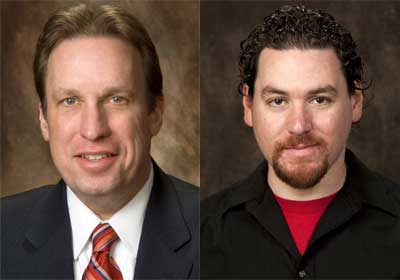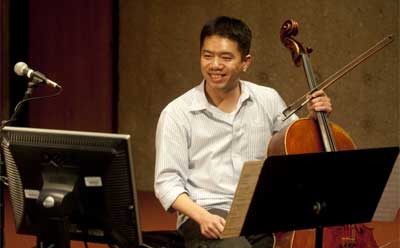
Cheng-Hou Lee performs via Internet2 for an audience in Philadelphia. He can see violinist Marjorie Bagley on the computer monitor.
Cheng-Hou Lee, cellist with NIU’s Avalon Quartet, waited inside the Recital Hall of the Music Building.
Meanwhile, his eventual audience listened to speeches in an auditorium some 825 miles away.
Among those speakers at the 2012 Internet2 Fall Member Meeting in Philadelphia was Dan Nichols, Lee’s colleague in the NIU School of Music and the multimedia specialist who makes Internet2 happen here.
Internet2 members already had head from Claudio Allocchio, senior technical officer of the GARR Italian Academic & Research Network, which developed the “LOLA” low latency technology with the Conservatorio G. Tartini in Trieste, Italy.
They also heard from Roberto Diaz, president and chief executive officer of Philadelphia’s Curtis Institute of Music, who led a discussion explaining the benefits of this technology advancement for music education and performance.
And then the moment arrived. Violinist Marjorie Bagley, from the University of North Carolina-Greensboro, took the stage in the City of Brotherly Love.
Bagley and Lee tuned their instruments and then, looking at each other on computer monitors, began to play a duet in real-time.
Their performance aptly demonstrated real-time, simultaneous, live musical performances across long distances enabled by low latency audio- and video-conferencing technology.
“Since Internet2’s inception, all across the world I have been asked by musicians, ‘Can we play together?’ and the answer has always been no,” said Ann Doyle, director of cultural collaborations for Internet2. “It is with gratitude to the LOLA project team, that the answer is now yes!”
Paul Bauer, director of the NIU School of Music, accompanied Nichols to the meeting.
Bauer, who long has championed the use of Internet2 for and by his faculty, remains excited by the possibilities.
“People are now talking of rehearsing in advance of guest appearances,” Bauer said. “Normally you have the guest artist arrive the day before and have a compressed schedule. Now we can rehearse weeks or months in advance together before they come on site. This will produce a more comfortable and more artistic performance and listening experience.
Called “LOLA,” the technology can reduce the latency down to effectively 35 milliseconds. This musically translates to 35 feet, which is like being on the opposite side of the stage from the musician.
High-speed data transfers and low latency are critical for those performances. Internet2 institutions starting to use LOLA include NIU, UNC-Greensboro, Curtis, the New World Symphony in Miami, University of Southern California and the University of Virginia.
Musicians are able to effectively play simultaneously and remotely with latency less than 60 milliseconds round-trip from microphone to musician.
Using an advanced network, LOLA provides a round-trip microphone to speaker latency between 20 to 50 milliseconds depending on distance and network configuration. Most commercial services produce a round-trip latency greater than 200 milliseconds. Latency in digital audio equipment is most noticeable when a singer’s voice is transmitted through their microphone, digital audio mixing, processing and routing paths.
Internet2 and the regional operating networks capitalize on research and education to create new applications and innovation. The Mid-Atlantic Gigapop in Philadelphia and the Illinois Century Network provided technical support for the demonstration.
Related:


